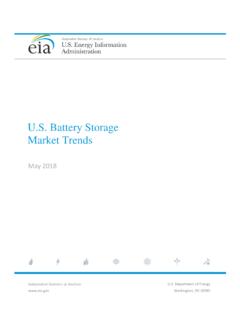Transcription of State of the States: Fuel Cells in 2014 - Energy
1 State of the States: fuel Cells in America 20145th EditionFuel Cell Technologies OfficeDecember 2014(This page intentionally left blank)Section title Unt utaerest in pos eum quo con et iAbout this ReportThe information contained in this report was collected from public records and websites, particularly fuel Cells 2000 s State fuel Cell and Hydrogen Database and North Carolina Solar Center s Database of State incentives for Renewables & Efficiency (DSIRE). Information was also gathered via direct contact with State and industry repre-sentatives as of July 31, 2014. This report is a follow-up to fuel Cells 2000 s 2013, 2012, 2011 and 2010 reports, State of the states : fuel Cells in America.
2 If we ve missed something in your State , please let us know at All of the information contained in this report is publicly report is being disseminated by the Department of Energy (DOE). As such, this document was pre-pared in compliance with Section 515 of the Treasury and General Government Appropriations Act for Fiscal Year 2001(Public Law 106-554) and information quality guidelines issued by DOE. Though this report does not constitute influential information, as that term is defined in DOE s information quality guidelines or the Office of Management and Budget s Information Quality Bulletin for Peer Review, the report was reviewed both internally and externally prior to publication.
3 This report has benefited from review by DOE s fuel Cell Technologies the United states government nor any agency thereof, nor any of their employees, makes any warranty, express or implied, or assumes any legal liability or responsibility for the accuracy, completeness, or usefulness of any information, apparatus, product, or process disclosed, or represents that its use would not infringe privately owned rights. Reference herein to any specific commercial product, process, or service by trade name, trademark, manufacturer, or otherwise does not necessarily constitute or imply its endorsement, recommendation, or favoring by the United states government or any agency and AcknowledgementsThis report was written and compiled by Sandra Curtin and Jennifer Gangi of the Breakthrough Technologies Institute (BTI) in Washington, DC.
4 Support was provided by the Department of Energy s Office of Energy Efficiency and Renewable Energy fuel Cell Technologies Office. Special thanks to Alan Wechsler (NYSERDA), Pat Valente (OFCC), Shannon Baxter (SCHFCA), Russ Keller (SCRA), Charlie Myers (Mass H2), Paul Aresta (CCAT), and Jonathan Foster (CaSFCC) for their help in collecting information on their respective BTIThe Breakthrough Technologies Institute (BTI) is a non-profit [501(c)(3)] independent, educational organization that identifies and promotes environmental and Energy technologies that can improve the human condition. BTI was established in 1993 to ensure that emerging technologies have a voice in environmental and Energy policy debates.
5 Front Cover Photo megawatt combined heat and power fuel cell power plant supporting a micro-grid at a university; source: FuelCell Energy , Inc. PlugPower fuel cell forklift refuels at the BMW plant in South Carolina source: DOEReliOn, a Plug Power company, Rail HybridPV-HFC Power System source: ReliOnSTATE OF THE states : fuel Cells IN 2014ii Section title Unt utaerest in pos eum quo con et(This page intentionally left blank)Section title Unt utaerest in pos eum quo con et iiiTable of ContentsAcronyms Used in this Report vFuel Cells .
6 Localized Energy with Global Reach 1 Why fuel Cells ? 1 Reliable Power 2 Utility Scale 3 Defending from Drought
7 4 Acquisitions and Expansion 4 Export Opportunities 5 U S Patently Strong in IP 6 Top fuel Cell states 62014 Top fuel Cell states 8 california 8 Connecticut 17 New York 23 Ohio
8 29 South Carolina 33 Gaining Ground 37 Hawaii 37 Massachusetts 40 New Jersey 43 Also Noteworthy 45 Pennsylvania 45 Rhode Island
9 45 Multi- State Efforts 46 Federal fuel Cell Dollars Flowing to states 48 Stationary fuel Cells Strengthen Grid, Reduce Emissions 53 Transportation Helping Drive Industry Growth 55 Material Handling Lifting U S 55 Fueling Infrastructure Support 56 Photo & Graphic
10 Credits 58 Appendix 1 - State Summary Chart 59 Appendix 2 Additional Resources 61 Appendix 3 Companies Included in the Report 63 Appendix 4 Glossary of Energy Regulatory Terms 65 Appendix 5 State Industry Group Survey Responses 66 State OF THE states .












